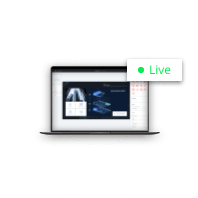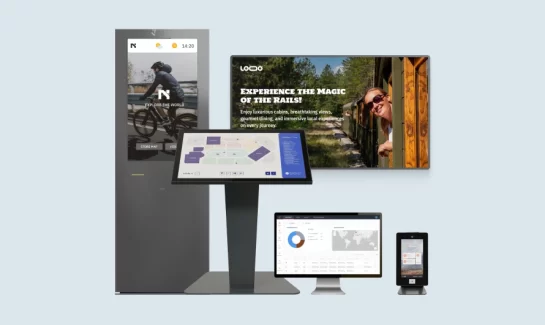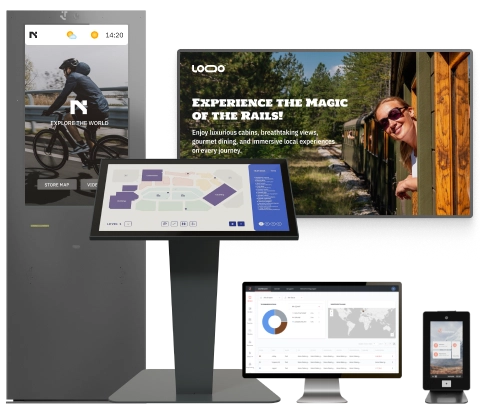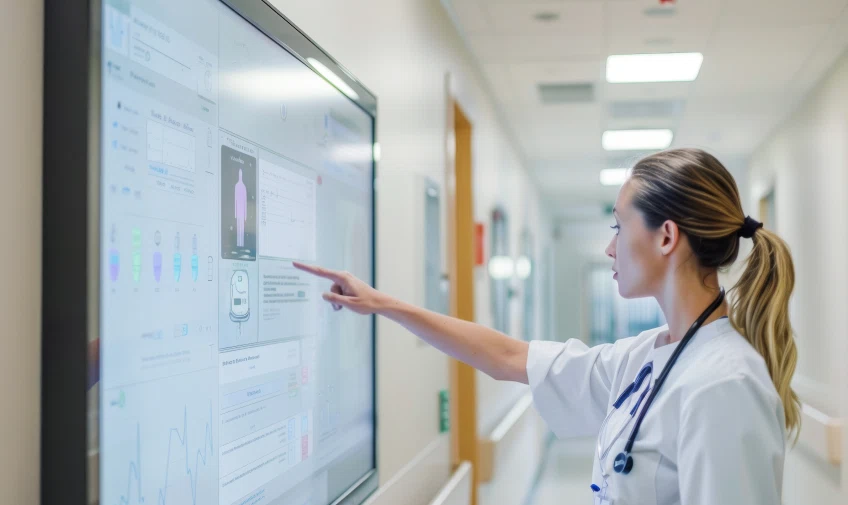
Public health depends not solely on medicine – it relies on communication that is clear, timely, and trusted. Today, we are flooded with information, so it becomes increasingly important to reach people where they are. Digital signage in public health has become a powerful communication tool that turns everyday spaces into channels for life-saving updates. Modern solutions use digital signage for government messaging to foster stronger community engagement.
friendlyway will create a tailored digital solution for you to keep everyone safe and informed at your facility.
The Role of Communication in Public Health
Many of the greatest public health successes – from vaccination campaigns to disease prevention programs – were made possible thanks to clear public health communication tools.
The importance of clear, consistent messaging
Public health experts emphasize that messages must be easy to understand and remain consistent across all channels. Contradictory guidance can erode public trust, so it’s important to use the same straightforward language repeatedly. It will help reinforce ideas so people will be more likely to remember them.
Challenges of reaching diverse and mobile populations
It’s not an easy task to reach everyone in a community. Populations are diverse: they speak different languages and have varying literacy levels. Besides, they consume information through different media. People are constantly on the move – commuting, traveling, or just busy.
Given this, health messages need to find people exactly where they are with effective digital communication in healthcare strategies.
The need for real-time updates during health crises
During fast-moving health crises, information can change by the day or even the hour. For example, if an outbreak occurs or a new hazard emerges, authorities need a way to immediately inform people through public health alerts. Real-time updates via digital signage guide public behavior and save lives.
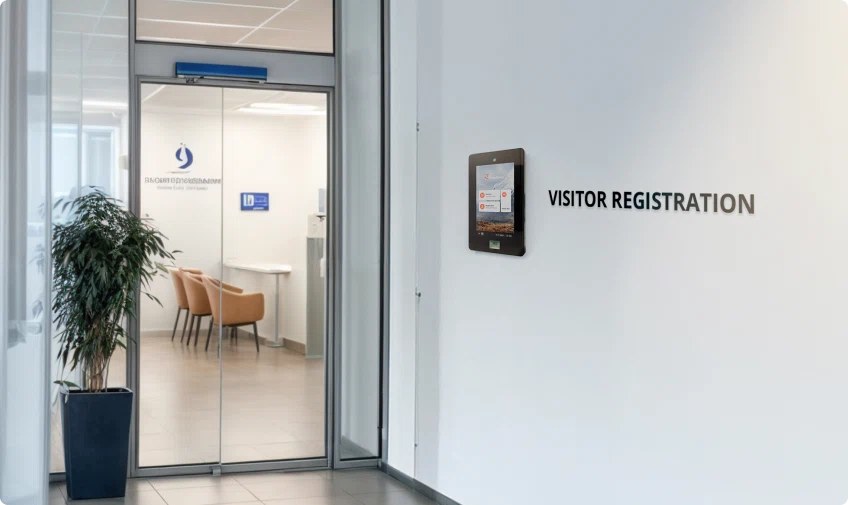
Why Digital Signage Is a Game-Changer for Health Communication
Digital signage has emerged as a powerful tool to provide timely information where people already are – in clinics, transit stations, government offices, and other public venues. These health safety digital displays improve accessibility, increase visibility, and ensure communities stay informed.
Instant delivery of urgent announcements
With digital signage networks, it becomes possible to push urgent announcements to screens citywide within minutes. This capability enables real-time health announcements that can be truly life-saving.
Visual and engaging content increases message retention
Digital signage is eye-catching, which improves message retention. Colorful infographics, short videos, and animations make the message stick.
Location-based targeting
Healthcare institutions can display health campaigns on digital screens in clinic waiting rooms or public buildings to show preventive care tips, vaccination reminders, or preparedness messages. Patients and citizens receive targeted updates exactly when and where they need them.
Multilingual and accessible content options
Unlike a one-language poster, digital signs can cycle through multiple languages at different times of day. They act as modern hospital communication tools that can also display the content in a viewer’s preferred language. Accessibility is another benefit: digital signage systems support audio or even sign-language video overlays for people with hearing or vision impairments.
Key Use Cases for Digital Signage in Public Health
Digital signage is already being put into action in various contexts. From the extraordinary demands of the pandemic to routine healthcare campaigns, digital signs have proven their high value. Further, we will highlight some key use cases where digital signage supports public health goals.
COVID-19 guidelines and vaccination information
Around the country, digital billboards and signs were used to amplify COVID-19 safety messages. Billboards and signs displayed safety measures and vaccination updates, often integrated with live feeds to deliver emergency health messaging and real-time signage updates about vaccine availability.
Seasonal flu prevention campaigns
Every fall, digital displays play a critical role in sharing flu-prevention measures. This form of health crisis signage ensures people adopt safer habits during outbreaks.
Hygiene education in schools and hospitals
Instead of faded posters, schools and hospitals can rely on interactive displays for health education that engage students and patients through animations or touch-enabled content.
Mental health awareness and resources
Public health communication isn’t just about physical wellness – it also extends to mental well-being. Public institutions like schools, universities, libraries, or community centers might use digital announcement boards not just for daily news but also to rotate in “wellness corner” content.
With contactless health communication, institutions can share tips and inspiration without requiring physical brochures or flyers. For example, they may display inspirational quotes, tips for stress management during exams, or information about psychological help available on campus.
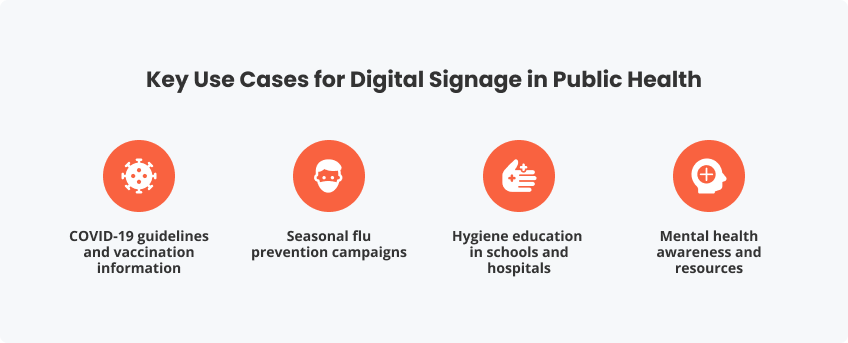
Benefits for Government Agencies and Healthcare Institutions
If you decide to invest in health education digital signage, it will definitely yield a host of benefits. Beyond effective communication, digital signage streamlines operations for healthcare organizations and even saves money in the long run.
Reduced communication lag and reliance on printed materials
With traditional methods such as press releases, printed flyers, and mailers, there’s an inherent lag. Digital signage, on the contrary, virtually eliminates that lag: you can create a message and deploy it to every screen in the network within minutes. In this case, no printing or physical distribution is required. This approach helps eliminate the additional costs associated with printing traditional signs.
Cost-effective campaign deployment
It goes without saying that digital signage requires an investment: software and hardware such as screens and media players. Nevertheless, when viewed over the long term, digital signage often turns out to be highly cost-effective in comparison with traditional outreach. After the installation, the marginal cost of running new campaigns is very low.
Centralized content management and real-time editing
With modern cloud-based infrastructure, a small team can manage content on dozens or even hundreds of screens. For large hospital systems, this is a game-changer: employees can have real-time access to the content no matter their current location.
Strengthened public trust and engagement
When used thoughtfully, public service messaging can significantly boost public engagement and trust in health institutions. It becomes possible thanks to the provision of correct, updated information. People tend to trust guidance that is frequent, visible, and consistent. In terms of engagement, digital signs are more interactive – users can search for the information they require and receive updates instantly.
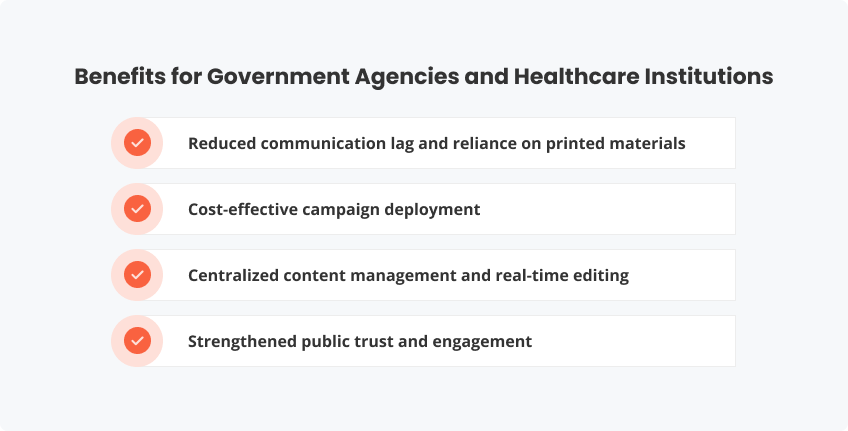
Implementation Tips
To leverage digital signage, it’s not enough to hang screens everywhere – a thoughtful strategy is needed to maximize impact. In this section, we provide practical tips on effective implementation.
Choosing high-visibility locations
When you choose the most suitable locations, it helps to map out the potential user journey: where does your intended audience go, and when would a health message be most relevant to them? You need to install screens in high-visibility, high-traffic locations where your target audience is likely to see them. Another useful tip is to mount screens at eye-level where possible.
Creating simple and visual messages
Although the technology is high-tech, the content should be simple and clear. Keep in mind that people often glance at these displays on the go. Do not overwhelm your audience with dense paragraphs or overly complex charts. A good rule of thumb from design experts is to stick to one main idea per screen. If you have multiple points, use a sequence of slides in a loop.
Using templates for emergency response
In emergencies, every second counts, including the time needed to put out a message. This is the reason why it’s smart to prepare emergency templates ahead of time. These templates should be very straightforward, since during a crisis, people need clear instructions, not fancy graphics.
Maintaining relevance with data-driven content
Digital signage is a live medium – it’s not static paper, it’s connected to the internet or a content system. You can pull information in real-time. Data-driven content keeps your signage timely and relevant, which keeps the audience’s interest.
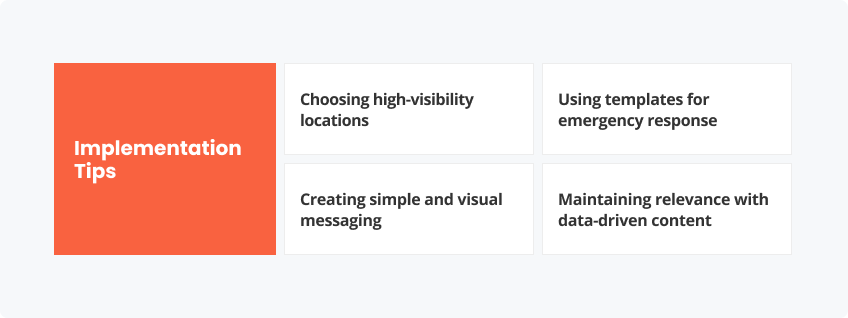
Conclusion
Digital signage is a vital tool that strengthens public health communication. It delivers clear, real-time, and multilingual updates in public spaces. Unlike static posters, digital displays capture attention with visuals and provide targeted messages. This helps create a future-proof communication channel that keeps citizens safe and engaged.
Implement the latest trends in digital signage with a trusted partner.
FAQ
Digital signage improves public health communication by making it more immediate, engaging, and far-reaching. With networked digital screens, health authorities can instantly broadcast crucial information and update it when necessary.
Absolutely. Digital signage is very effective for multilingual health messaging because it offers flexibility that printed signs lack.
Yes, one of the biggest advantages of digital signage networks is the ability to update messages in real time across all connected devices.
While traditional signage may be cheaper for one-time use, digital signage is more cost-effective for frequent updates, especially for public health alerts and ongoing campaigns.
For maximum visibility, place health signage where your intended audience is guaranteed to see it. Here are a few prime examples: entrances and lobbies, waiting areas, transit hubs, and community gathering points.
